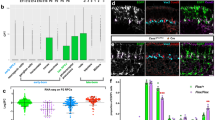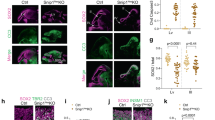Abstract
Self-renewal and differentiation are cardinal features of stem cells. Asymmetric cell division provides one fundamental mechanism by which stem cell self-renewal and differentiation are balanced1,2. A failure of this balance could lead to diseases such as cancer3,4,5,6. During asymmetric division of stem cells, factors controlling their self-renewal and differentiation are unequally segregated between daughter cells. Numb is one such factor that is segregated to the differentiating daughter cell during the stem-cell-like neuroblast divisions in Drosophila melanogaster7, where it inhibits self-renewal8,9. The localization and function of Numb is cell-cycle-dependent7,10,11,12. Here we show that Polo (ref. 13), a key cell cycle regulator, the mammalian counterparts of which have been implicated as oncogenes as well as tumour suppressors14,15, acts as a tumour suppressor in the larval brain. Supernumerary neuroblasts are produced at the expense of neurons in polo mutants. Polo directly phosphorylates Partner of Numb (Pon, ref. 16), an adaptor protein for Numb, and this phosphorylation event is important for Pon to localize Numb. In polo mutants, the asymmetric localization of Pon, Numb and atypical protein kinase C are disrupted, whereas other polarity markers are largely unaffected. Overexpression of Numb suppresses neuroblast overproliferation caused by polo mutations, suggesting that Numb has a major role in mediating this effect of Polo. Our results reveal a biochemical link between the cell cycle and the asymmetric protein localization machinery, and indicate that Polo can inhibit progenitor self-renewal by regulating the localization and function of Numb.
This is a preview of subscription content, access via your institution
Access options
Subscribe to this journal
Receive 51 print issues and online access
$199.00 per year
only $3.90 per issue
Buy this article
- Purchase on Springer Link
- Instant access to full article PDF
Prices may be subject to local taxes which are calculated during checkout




Similar content being viewed by others
References
Morrison, S. J. & Kimble, J. Asymmetric and symmetric stem-cell divisions in development and cancer. Nature 441, 1068–1074 (2006)
Jan, Y. N. & Jan, L. Y. Asymmetric cell division in the Drosophila nervous system. Nature Rev. Neurosci. 2, 772–779 (2001)
Caussinus, E. & Gonzalez, C. Induction of tumor growth by altered stem-cell asymmetric division in Drosophila melanogaster. Nature Genet. 37, 1125–1129 (2005)
Betschinger, J., Mechtler, K. & Knoblich, J. A. Asymmetric segregation of the tumor suppressor Brat regulates self-renewal in Drosophila neural stem cells. Cell 124, 1241–1253 (2006)
Lee, C. Y., Wilkinson, B. D., Siegrist, S. E., Wharton, R. P. & Doe, C. Q. Brat is a Miranda cargo protein that promotes neuronal differentiation and inhibits neuroblast self-renewal. Dev. Cell 10, 441–449 (2006)
Bello, B., Reichert, H. & Hirth, F. The brain tumor gene negatively regulates neural progenitor cell proliferation in the larval central brain of Drosophila. Development 133, 2639–2648 (2006)
Rhyu, M. S., Jan, L. Y. & Jan, Y. N. Asymmetric distribution of numb protein during division of the sensory organ precursor cell confers distinct fates to daughter cells. Cell 76, 477–491 (1994)
Lee, C. Y. et al. Drosophila Aurora-A kinase inhibits neuroblast self-renewal by regulating aPKC/Numb cortical polarity and spindle orientation. Genes Dev. 20, 3464–3474 (2006)
Wang, H. et al. Aurora-A acts as a tumor suppressor and regulates self-renewal of Drosophila neuroblasts. Genes Dev. 20, 3453–3463 (2006)
Tio, M., Udolph, G., Yang, X. & Chia, W. cdc2 links the Drosophila cell cycle and asymmetric division machineries. Nature 409, 1063–1067 (2001)
Knoblich, J. A., Jan, L. Y. & Jan, Y. N. Asymmetric segregation of Numb and Prospero during cell division. Nature 377, 624–627 (1995)
Zhou, Y. et al. The mammalian Golgi regulates numb signaling in asymmetric cell division by releasing ACBD3 during mitosis. Cell 129, 163–178 (2007)
Sunkel, C. E. & Glover, D. M. polo, a mitotic mutant of Drosophila displaying abnormal spindle poles. J. Cell Sci. 89, 25–38 (1988)
Barr, F. A., Sillje, H. H. & Nigg, E. A. Polo-like kinases and the orchestration of cell division. Nature Rev. Mol. Cell Biol. 5, 429–440 (2004)
van de Weerdt, B. C. & Medema, R. H. Polo-like kinases: a team in control of the division. Cell Cycle 5, 853–864 (2006)
Lu, B., Rothenberg, M., Jan, L. Y. & Jan, Y. N. Partner of Numb colocalizes with Numb during mitosis and directs Numb asymmetric localization in Drosophila neural and muscle progenitors. Cell 95, 225–235 (1998)
Lu, B., Ackerman, L., Jan, L. Y. & Jan, Y. N. Modes of protein movement that lead to the asymmetric localization of partner of Numb during Drosophila neuroblast division. Mol. Cell 4, 883–891 (1999)
Lee, C. Y., Robinson, K. J. & Doe, C. Q. Lgl, Pins and aPKC regulate neuroblast self-renewal versus differentiation. Nature 439, 594–598 (2006)
Izumi, Y., Ohta, N., Hisata, K., Raabe, T. & Matsuzaki, F. Drosophila Pins-binding protein Mud regulates spindle-polarity coupling and centrosome organization. Nature Cell Biol. 8, 586–593 (2006)
Siller, K. H., Cabernard, C. & Doe, C. Q. The NuMA-related Mud protein binds Pins and regulates spindle orientation in Drosophila neuroblasts. Nature Cell Biol. 8, 594–600 (2006)
Smith, C. A. et al. aPKC-mediated phosphorylation regulates asymmetric membrane localization of the cell fate determinant Numb. EMBO J. 26, 468–480 (2007)
Bhalerao, S., Berdnik, D., Torok, T. & Knoblich, J. A. Localization-dependent and -independent roles of numb contribute to cell-fate specification in Drosophila. Curr. Biol. 15, 1583–1590 (2005)
Moutinho-Santos, T., Sampaio, P., Amorim, I., Costa, M. & Sunkel, C. E. In vivo localisation of the mitotic POLO kinase shows a highly dynamic association with the mitotic apparatus during early embryogenesis in Drosophila. Biol. Cell 91, 585–596 (1999)
Berdnik, D. & Knoblich, J. A. Drosophila Aurora-A is required for centrosome maturation and actin-dependent asymmetric protein localization during mitosis. Curr. Biol. 12, 640–647 (2002)
Choksi, S. P. et al. Prospero acts as a binary switch between self-renewal and differentiation in Drosophila neural stem cells. Dev. Cell 11, 775–789 (2006)
Pece, S. et al. Loss of negative regulation by Numb over Notch is relevant to human breast carcinogenesis. J. Cell Biol. 167, 215–221 (2004)
Stylianou, S., Clarke, R. B. & Brennan, K. Aberrant activation of Notch signaling in human breast cancer. Cancer Res. 66, 1517–1525 (2006)
Clarke, A. S., Tang, T. T., Ooi, D. L. & Orr-Weaver, T. L. POLO kinase regulates the Drosophila centromere cohesion protein MEI-S332. Dev. Cell 8, 53–64 (2005)
Ohshiro, T., Yagami, T., Zhang, C. & Matsuzaki, F. Role of cortical tumour-suppressor proteins in asymmetric division of Drosophila neuroblast. Nature 408, 593–596 (2000)
Nishimura, I., Yang, Y. & Lu, B. PAR-1 kinase plays an initiator role in a temporally ordered phosphorylation process that confers tau toxicity in Drosophila. Cell 116, 671–682 (2004)
Acknowledgements
We thank D. Glover, F. Matsuzaki, Y. N. Jan, A. Wodarz, C. Doe, J. Knoblich, L. Luo, T. Orr-Weaver, C. Sunkel, B. Edgar, H. Richardson, F. Schweisguth, J. B. Skeath, A. Gould, E. D. Schejter, the Developmental Studies Hybridoma Bank and the Bloomington Stock Center for fly stocks and antibodies. We thank S. Guo for reading the manuscript, and F. Yu and members of the Lu and Chia laboratories for discussion and help. H.W. thanks U. Heberlein for support and S. G. S. Ling for technical help. This was supported by a NIH grant (B.L.) and Temasek Lifesciences Laboratory funding (W.C.)
Author information
Authors and Affiliations
Corresponding authors
Ethics declarations
Competing interests
Reprints and permissions information is available at www.nature.com/reprints. The authors declare no competing financial interests.
Supplementary information
Supplementary Figures
This file contains Supplementary Figures S-S11 with Legends. (PDF 3883 kb)
Rights and permissions
About this article
Cite this article
Wang, H., Ouyang, Y., Somers, W. et al. Polo inhibits progenitor self-renewal and regulates Numb asymmetry by phosphorylating Pon. Nature 449, 96–100 (2007). https://doi.org/10.1038/nature06056
Received:
Accepted:
Issue Date:
DOI: https://doi.org/10.1038/nature06056
This article is cited by
-
Therapeutic Effectiveness of Anticancer Agents Targeting Different Signaling Molecules Involved in Asymmetric Division of Cancer Stem Cell
Stem Cell Reviews and Reports (2023)
-
Depletion of kinesin motor KIF20A to target cell fate control suppresses medulloblastoma tumour growth
Communications Biology (2021)
-
The Drosophila Forkhead/Fox transcription factor Jumeau mediates specific cardiac progenitor cell divisions by regulating expression of the kinesin Nebbish
Scientific Reports (2021)
-
A spatiotemporal molecular switch governs plant asymmetric cell division
Nature Plants (2021)
-
Endosomes, lysosomes, and the role of endosomal and lysosomal biogenesis in cancer development
Molecular Biology Reports (2020)
Comments
By submitting a comment you agree to abide by our Terms and Community Guidelines. If you find something abusive or that does not comply with our terms or guidelines please flag it as inappropriate.



